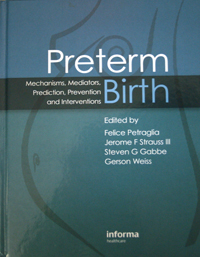
Perinatal morbidity, mortality examined
“Preterm Birth,” a soon-to-be-released textbook featuring Society for Gynecologic Investigation (SGI) papers from around the world, seeks to further important research into the leading cause of perinatal mortality and morbidity.
SGI investigators organized this effort in Sienna, Italy, in November 2005, while School of Medicine Dean Steven Gabbe, M.D., was serving as president of the international society of more than 1,000 members.
The book is published by Informa Healthcare in association with SGI and represents state-of-the-art research on issues leading to preterm birth deaths — mechanisms, mediators, prediction, prevention and interventions.
“The rate of preterm birth is actually going up in this country and there are a number of factors contributing to that increase. It is very frustrating despite everything that is being done,” said Gabbe, one of four editors on the project.
“In the past our focus was too much on the patient who is already in preterm labor — what causes the uterine muscle to contract and how can we stop it. But people now realize that is overly simplistic.”
Gabbe said the new material will be used at Vanderbilt and worldwide to educate students, residents, fellows and obstetricians and gynecologists about the many factors that can contribute to preterm delivery — inflammation, infection, stress, vascular disease, fetal signals.
“It is a multi-factorial problem and I think we didn't realize that for a long time,” he said. “Hopefully, by understanding these factors that contribute to preterm birth we will develop better strategies to prevent preterm labor from happening.”
“For example, a study recently launched by Patricia Temple, M.D., and Melanie Lutenbacher, Ph.D., M.S.N., is designed to determine whether the use of prenatal progesterone combined with medical and biobehavioral interventions can prevent premature births and delay subsequent pregnancies in women with a history of preterm births.”
Gabbe edited the book along with Felice Petraglia, M.D., professor and chair of Obstetrics and Gynecology at the University of Siena, Italy; Virginia Commonwealth University School of Medicine Dean Jerome Strauss III, M.D., Ph.D.; and Gerson Weiss, M.D., chair of Obstetrics and Gynecology at the University of Medicine and Dentistry of New Jersey.
It has not been released, according to the Amazon.com Web site, but can be pre-ordered to ship when it arrives.
SGI, the premier scientific organization in obstetrics and gynecology, had its beginnings when a small group of investigators studying hypertensive disorders of pregnancy proposed formation of an “Eclampsia” or “Toxemia” society. The first official meeting was held June 15, 1953, at the Yale Club in New York City.
“The Society of University Gynecologists” was adopted as the organization's name. At the second annual meeting, in Chicago, the name was formally changed to “The Society for Gynecologic investigation.” The acronym SGI was applied shortly thereafter.













